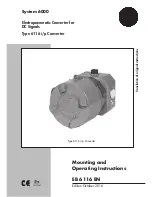
Page No 2
Foreseen Use Of The Tool
-
5263
This tool is designed for the purposes of cleaning and restoring stone and concrete, etc. and for cleaning and
particularly removing paint and rust, etc. from metals. The tool is powered by a free oscillating piston, which strikes
a needle holder containing several hardened needles. The needles have some free movement, which allows the
tool to clean around irregular shaped surfaces. Do not use the tool for any other purposes than that for which it was
designed. Do not modify the tool for any other purpose than that for which it was designed even for its purpose as a
needle scaler, unless first agreeing any such alternative use or modifications, with the manufacturer or an
authorized representative. The main applications for the tool is cleaning, deslagging and shot peening of welded
joints, cleaning metal surfaces of rust, scale and paint, cleaning castings, removing cores, cleaning brick and
stonework and cleaning ship plates, barges and buoys.
Work Stations
The tool should only be used as a handheld, hand operated tool. It is always recommended that the tool is used
when standing on a solid floor. It can be used in other positions, but before any such use, the operator must be in
a secure position having a firm grip and footing and be aware of the extra safety precautions that must be observed
when using a needle scaler.
Putting Into Service
Air Supply
Use a clean lubricated air supply that will give a measured air pressure at the tool of 90 PSlG (6.2 bar) when the
tool is running with the trigger/lever fully depressed. Use recommended hose size and length. It is recommended
that the tool is connected to the air supply as shown in figure 1. Do not connect the tool to the air line system
without Incorporating an easy to reach and operate air shut off valve. The air supply should be lubricated. It is
strongly recommended that an air filter, regulator, lubricator (FRL) is used as shown in Figure 1 as this will supply
clean, lubricated air at the correct pressure to the tool. Details of such equipment can be obtained from your
supplier. If such equipment is not used, then the tool should be lubricated by shutting off the air supply to the tool,
depressurizing the line by pressing the trigger on the tool. Disconnect the air line and pour into the hose adaptor a
teaspoonful (5ml) of a suitable pneumatic motor lubricating oil preferably incorporating a rust inhibitor. Reconnect
tool to air supply and run tool slowly for a few seconds to allow air to circulate the oil. If tool is used frequently,
lubricate on daily basis and if tool starts to slow or lose power. It is recommended that the air pressure at the tool
while the tool is running is 90 PSI162 bar.
Operating
Connect tool to a suitable air supply after having adjusted the position of the front needle cover, so that the needles
project from the front end of the tool by the required amount, When using the tool, keep the tool loaded sufficiently
to do the work. Do not overload the tool as this will reduce the power. Never operate the throttle lever unless the
needles are in contact with the working surface. Do not run the tool unless the retainer is fitted. Always use correct
size needles to match the tool. Do not store needles at freezing or below freezing temperatures as this can make
hardened steel tools brittle, which can cause breakage and lead to serious injury. Do not continue to use the tool
with broken needles as this may damage the tool. Be aware that needles worn/blunt at cutting edge should not be
used as such conditions promote tool breakage, reduce efficiency and increase vibration. NOTE: Use only suitable
pneumatic tool lubricants.
Dismantling & Assembly Instructions
Disconnect tool from air supply.
Unscrew 2 cap screws (22) with washers (23) and unscrew, pull off front tube (21) and intermediate tube (20) with spring
(19), needles (18), needle holder (17) and anvil (16). Unscrew cylinder (10) with O-rings (11) and (12) from body (13).
Remove piston (9) from cylinder (10). Drive out roll pin (8) and take off lover (7). Unscrew valve cap (1) with O-ring (2) and
take out valve spring (3), valve stem (4) and O-ring valve seat (5). Valve body (6) may be unscrewed from and rubber
handle grip (15) removed from housing (13), if replacements are required.
Reassembly
Clean all parts and examine for wear. Replace any parts with parts obtained from the manufacturer or an authorized
distributor. Lightly coat all parts with a suitable pneumatic tool lubricating oil and assemble in reverse order.























